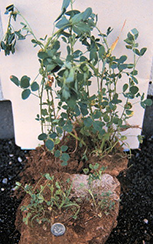Aphanomyces Root Rot in Alfalfa
Aphanomyces Root Rot
Symptoms
Seedlings affected exhibit severe stunting of internodes, petioles, and leaf blades. The seed leaves (cotyledons)

Plant with Aphanomyces
commonly are yellow, and may exhibit reddening, especially on the underside. Leaf blades exhibit a bluish-green cast. Seedlings typically do not wilt or collapse. Roots of affected plants exhibit light brown discoloration. Commonly, the problem affects most or all of the field, although it may be worse in more poorly drained areas.
Cause
The causal agent is Aphanomyces euteiches, which survives as oospores in the soil or diseased plant tissue. Because infection occurs when soils are water saturated, Aphanomyces root rot is associated with poorly drained soils . It is a common stand-establishment problem when spring-seeded alfalfa is followed by extended periods of wet weather, especially within 4-6 weeks of seeding. Aphanomyces is easily confused with other root problems also found in plants growing in flooded soils. Infected plants that are moderately diseased may resemble symptoms of nitrogen deficiency; severely affected plants are extremely stunted.
IPM Techniques
- Examine plants in the field about 6-8 weeks after seeding. Examine five sites at least 10-20 feet from the field edge, especially in wetter areas of the field. Report severity of the disease according to the following scale:
0 = no plants diseased
1 = less than 25% of plants in the site have modest stunting and yellowing
2 = over 25% of plants are showing symptoms; some scattered plants may show severe stunting
3 = over half of the plants at the site are extremely stunted (less than two inches tall) six weeks after seeding.
- Use varieties with an R or HR rating to Aphanomyces.
- Use soil and water management practices that improve soil drainage.
References and Additional Information
- IPM-1 Kentucky Alfalfa Manual
Compendium of Alfalfa Diseases. 2nd ed. Stuteville, D.L. & D.C. Erwin, (eds.). 1990


